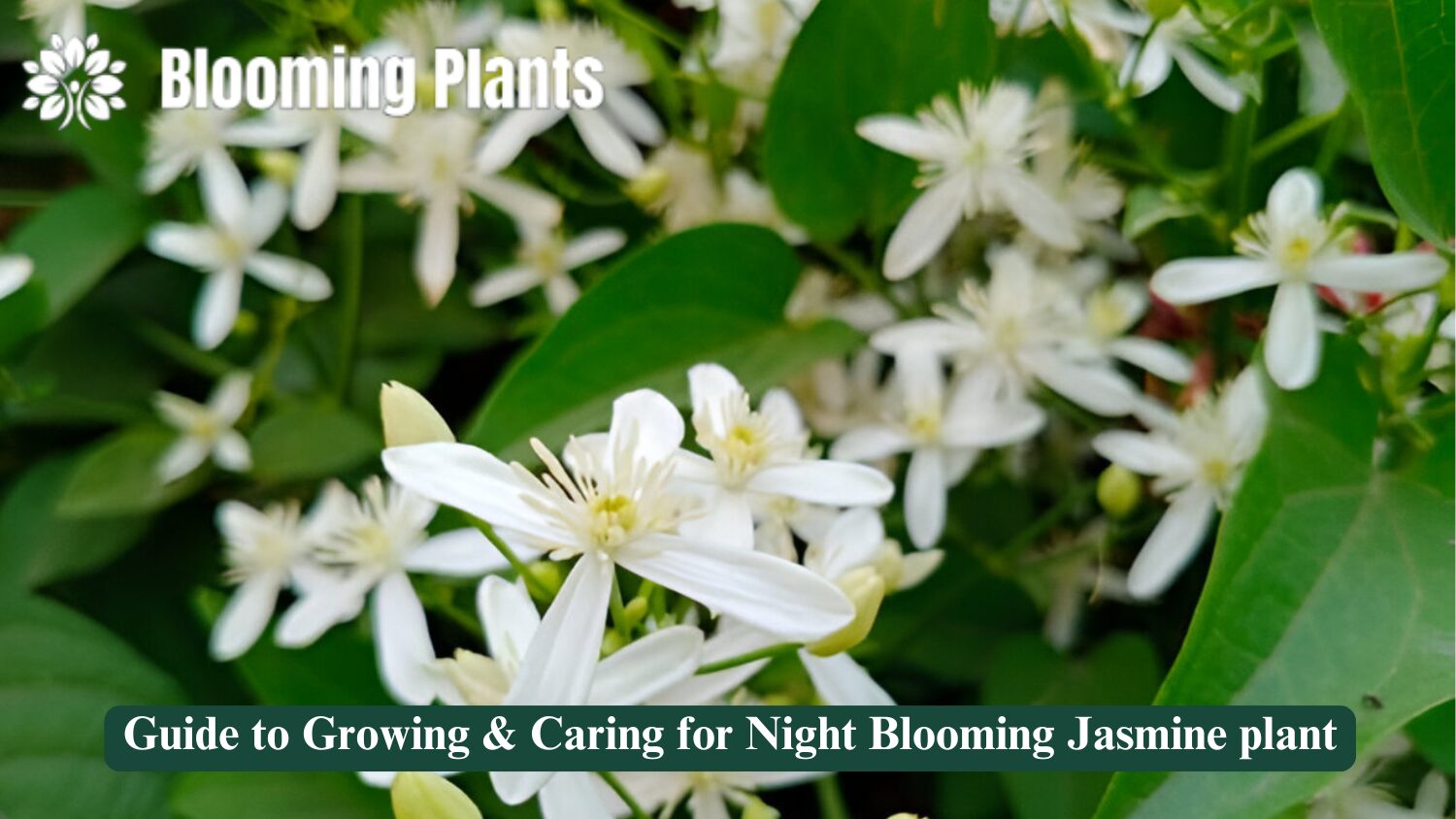Night-blooming jasmine plants, also known as Cestrum nocturnum, are a gardener’s dream. Famous for their intoxicating fragrance, these nocturnal wonders thrive in the moonlight, making them a beautiful and aromatic addition to your garden. If you’re captivated by their charm and want to cultivate them successfully, this comprehensive guide has you covered. From their origins and benefits to step-by-step care tips, we’ve included everything you need to know.
What Are Night-Blooming Jasmine Plants?
Botanical Overview
- Scientific Name: Cestrum nocturnum
- Common Names: Night-blooming jasmine, night-blooming Jessamine, queen of the night
- Family: Solanaceae (Nightshade family)
- Origin: Native to tropical and subtropical regions of the Americas
Appearance
Night-blooming jasmine plants are evergreen shrubs that typically grow 8–12 feet tall. Their slender, arching branches are adorned with glossy green leaves. The star of the show, however, is their tubular, cream-coloured flowers that bloom after sunset and release a sweet, intense fragrance.
Fragrance Profile
The fragrance of night-blooming jasmine is its signature feature. It’s sweet and heady, most potent during the evening and early morning hours. Many compare the scent to a blend of honeysuckle and jasmine, though it’s uniquely its own.
Why Grow Night Blooming Jasmine?
Benefits of Cultivating Night Blooming Jasmine
- Fragrance: Enhances outdoor spaces with a delightful aroma.
- Pollinator Attraction: Draws moths and night-pollinating insects, which are essential for ecosystem health.
- Easy Maintenance: A hardy plant that thrives in various conditions.
- Ornamental Value: Adds visual and sensory appeal to gardens.
- Cultural Significance: Revered in many cultures for its symbolic and medicinal properties.
Common Uses
- Landscaping: Perfect for hedges, borders, or as a standalone feature.
- Potted Plants: Ideal for patios or balconies.
- Aromatherapy: Flowers are used in potpourri and oils.
- Traditional Medicine: Known for its anti-inflammatory and antibacterial properties in some cultures.
How to Grow Night Blooming Jasmine
Choosing the Right Location
- Sunlight: Thrives in full sun to partial shade. Ensure at least 4-6 hours of sunlight daily.
- Climate: Prefers tropical and subtropical climates. It can be grown in USDA zones 9-11.
- Soil: Well-draining soil with a slightly acidic to neutral pH (6.0-7.0) is ideal.
Planting Instructions
- Prepare the soil: Loosen the soil to ensure good aeration. Mix in compost or organic matter for nutrients.
- Dig the Hole: Make a hole twice the size of the root ball.
- Planting: Place the plant in the hole, backfill with soil, and water thoroughly.
- Spacing: Maintain a spacing of 3-5 feet between plants to allow proper air circulation.
Propagation Methods
- Cuttings: The easiest and most common method. Use semi-hardwood cuttings, about 6-8 inches long, dipped in rooting hormone.
- Seeds: While less common, seeds can be germinated indoors. Soak seeds overnight before planting.
Caring for Night Blooming Jasmine
Watering
- Frequency: Keep the soil consistently moist, especially during the growing season. Water deeply once or twice a week.
- Tips: Avoid overwatering to prevent root rot. Allow the topsoil to dry slightly between waterings.
Fertilizing
- Type: Use a balanced, slow-release fertilizer (10-10-10) during the growing season.
- Frequency: Fertilize once a month in spring and summer. Reduce feeding in the fall.
Pruning
- When to prune: late winter or early spring, before new growth begins.
- How to prune: Remove dead, damaged, or overcrowded branches. Trim back by one-third to maintain shape and encourage blooming.
Pest and Disease Management
| Pest/Disease | Symptoms | Solution |
| Aphids | Sticky residue on leaves | Spray with neem oil or insecticidal soap |
| Whiteflies | Yellowing leaves, stunted growth | Introduce beneficial insects like ladybugs |
| Root Rot | Wilting, mushy roots | Improve drainage and reduce watering |
Blooming and Seasonal Care
Flowering Cycle
Night-blooming jasmine typically blooms from late spring to early fall. The flowers open in the evening and release their fragrance throughout the night.
Winter Care
- In mild climates, mulch around the base to protect roots from frost.
- In cold climates: Move potted plants indoors or to a greenhouse. Reduce watering during dormancy.
Interesting Facts and Tips
- Not True Jasmine: Despite its name, night blooming jasmine is not a true jasmine but belongs to the nightshade family.
- Toxicity Warning: The plant’s berries are toxic to humans and pets if ingested. Keep out of reach of children and animals.
- Companion Plants: Pair with moonflower or angel’s trumpet for a nighttime garden that’s both fragrant and visually stunning.
- Cultural Significance: In India, the plant is often associated with love and romance, symbolizing the allure of the night.
FAQ
How Fast Does Night-Blooming Jasmine Grow?
Under optimal conditions, it grows rapidly, gaining 2-4 feet per year.
Does It Require Special Soil?
No, but well-draining, nutrient-rich soil ensures the healthiest growth.
Can It Be Grown Indoors?
Yes, but it needs a sunny window and regular pruning to prevent overgrowth.
Conclusion
Night-blooming jasmine plants are more than just fragrant beauties—they’re a gateway to creating a magical garden experience. With the proper care and attention, these plants will reward you with their alluring nighttime blooms and rich, sweet aroma. Whether you’re a seasoned gardener or a beginner, this guide equips you with all the tools to grow and maintain your own nightblooming jasmine plants successfully.
Ready to bring a touch of magic to your garden? Start planting today and transform your evenings with the mesmerizing charm of night-blooming jasmine.

